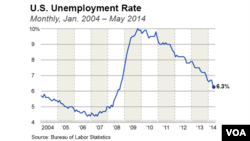WASHINGTON —
US Employers Add 217,000 Jobs; Unemployment Steady at 6.3%
U.S. employers added another 217,000 jobs in May. That’s the fourth straight month of job gains above 200,000. The job gains in May could mean the economy now has recovered all the jobs lost during the recession, but the unemployment rate was unchanged at 6.3 percent because more Americans went looking for work.
After a difficult winter, the US job market is showing signs of life. The Labor Department says job gains in May were broad-based - rising in healthcare, the leisure, hospitality and manufacturing sectors.
And despite worries that U.S. stock prices may be due for a major correction, investment strategist Kate Warne said slow and steady wins the day.
"In addition, we think sentiment is actually improving a little. The skepticism that everybody feels is actually positive because it means nobody's gotten too excited, too euphoric, at a time like this," said Warne.
Despite the improving jobs picture, the unemployment rate held steady as unemployed Americans resumed their job search. Economists say that’s a sign of confidence in the economy. One worry, though, is that average wages have remained mostly flat.
Mark Hamrick at Bankrate.com said that hurts consumer confidence.
“One thing that would really help them to see a much better mood is if their incomes were to grow, if they have more money in their pockets and they don’t have to spend it all on gasoline or utilities to heat their homes as they did during the winter time. I think that would really help consumer confidence,” said Hamrick.
Another concern is that job growth remains uneven. A new report by the National Council of La Raza says the unemployment rate for Latinos is still higher than for the general population. Not only that, policy analyst Alicia Criado said the majority of gains for Latinos have been in lower-paying jobs.
“Or jobs that don’t keep workers out of poverty. And that’s definitely the case for millions of Latino workers who are increasingly filling jobs in the low-wage sector,” said Criado.
Although the economy now has regained the number of jobs lost since the downturn, job growth has not kept up with the U.S. population, which has grown nearly seven percent since the end of the Great Recession.
U.S. employers added another 217,000 jobs in May. That’s the fourth straight month of job gains above 200,000. The job gains in May could mean the economy now has recovered all the jobs lost during the recession, but the unemployment rate was unchanged at 6.3 percent because more Americans went looking for work.
After a difficult winter, the US job market is showing signs of life. The Labor Department says job gains in May were broad-based - rising in healthcare, the leisure, hospitality and manufacturing sectors.
And despite worries that U.S. stock prices may be due for a major correction, investment strategist Kate Warne said slow and steady wins the day.
"In addition, we think sentiment is actually improving a little. The skepticism that everybody feels is actually positive because it means nobody's gotten too excited, too euphoric, at a time like this," said Warne.
Despite the improving jobs picture, the unemployment rate held steady as unemployed Americans resumed their job search. Economists say that’s a sign of confidence in the economy. One worry, though, is that average wages have remained mostly flat.
Mark Hamrick at Bankrate.com said that hurts consumer confidence.
“One thing that would really help them to see a much better mood is if their incomes were to grow, if they have more money in their pockets and they don’t have to spend it all on gasoline or utilities to heat their homes as they did during the winter time. I think that would really help consumer confidence,” said Hamrick.
Another concern is that job growth remains uneven. A new report by the National Council of La Raza says the unemployment rate for Latinos is still higher than for the general population. Not only that, policy analyst Alicia Criado said the majority of gains for Latinos have been in lower-paying jobs.
“Or jobs that don’t keep workers out of poverty. And that’s definitely the case for millions of Latino workers who are increasingly filling jobs in the low-wage sector,” said Criado.
Although the economy now has regained the number of jobs lost since the downturn, job growth has not kept up with the U.S. population, which has grown nearly seven percent since the end of the Great Recession.










